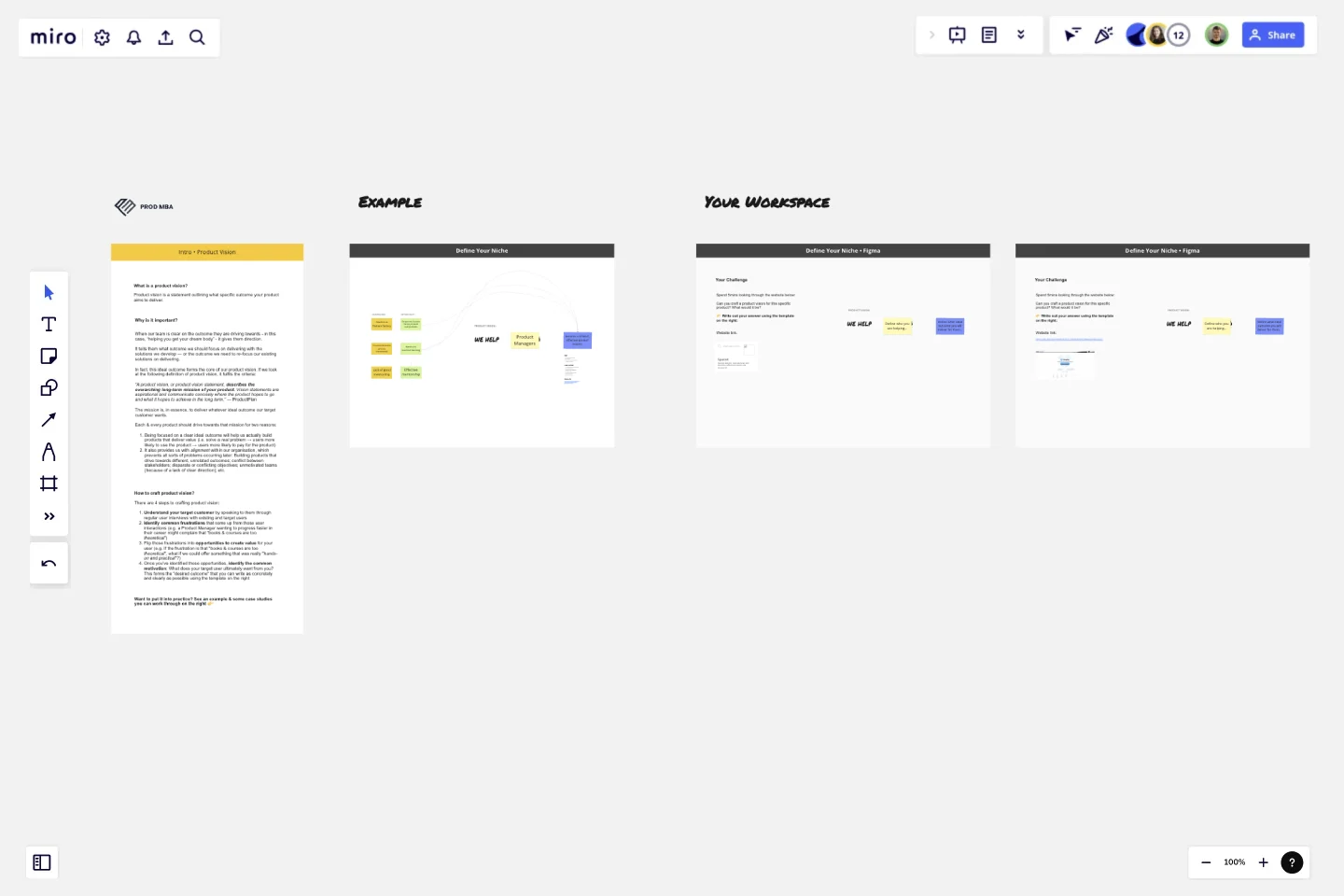Define A Winning Product Vision
Product vision is a statement outlining what specific outcome your product aims to deliver.
This template is the foundation for:
1. Focusing your products on what really matters
Why? Being focused on a clear ideal outcome will help us actually build products that deliver value (i.e., solve a real problem → users more likely to use the product → users more likely to pay for the product)
2. Alignment
Product Vision also provides us with alignment within our organization, which prevents all sorts of problems from occurring later: Building products that drive towards different, unrelated outcomes; conflict between stakeholders; disparate or conflicting objectives; unmotivated teams (because of a lack of clear direction); etc.-This template is a powerful way for product leaders to craft a winning product vision with their teams.We suggest going through the real-world examples as part of a workshop before getting your team to craft their own versions of your product vision before finally aligning as a group on which one you feel would be best for your product.
This template is a powerful way for product leaders to craft a winning product vision with their teams.
We suggest going through the real-world examples as part of a workshop before getting your team to craft their own versions of your product vision before finally aligning as a group on which one you feel would be best for your product.
This template was created by Prod MBA.
Get started with this template right now.
Features Audit Template
Works best for:
Desk Research, Product Management, User Experience
Add new features or improve existing features—those are the two paths toward improving a product. But which should you take? A features audit will help you decide. This easy, powerful product management tool will give you a way to examine all of your features, then gather research and have detailed discussions about the ones that simply aren’t working. Then you can decide if you should increase those features’ visibility or the frequency with which it’s used—or if you should remove it altogether.
Calendar 2024 - a Year timeline
Works best for:
Strategy, Planning
The Calendar 2024 a year Timeline template is perfect for planning and organizing your year. It helps you schedule important dates, track annual goals, and stay on top of deadlines. This template ensures you have a clear overview of your year ahead.
Multiple-Product Roadmap
Works best for:
Planning, Mapping
The Multiple Product Roadmap template empowers product managers to visualize and manage multiple product initiatives effectively. By providing a centralized view of project timelines, dependencies, and milestones, this template fosters alignment and transparency across teams. With sections for prioritizing initiatives, tracking progress, and communicating updates, it enables teams to coordinate efforts and drive collective success. This template serves as a strategic tool for planning and executing product roadmaps that align with organizational goals and drive business growth.
Product Management - Product Flow
Works best for:
Product Management, Planning
Product Management - Product Flow template enables product managers to visualize and streamline product development processes. By mapping out key stages, tasks, and dependencies, this template enhances workflow transparency and coordination. With features for identifying bottlenecks and optimizing resource allocation, it empowers teams to improve efficiency and accelerate product delivery. This template serves as a valuable tool for ensuring smooth product development and launch processes, ultimately driving better outcomes.
Scenario Planning Template
Works best for:
Planning
The Scenario Planning Template simplifies the complex process of strategizing and envisioning various future scenarios. The template’s clear structure helps teams and individuals effectively navigate the multifaceted steps of project planning and execution. A standout benefit of this template is its capability to foster structured thinking. With its distinct sections ranging from definition to action, it ensures that ideas are organized coherently, promoting logical progression and reducing the chances of oversight, making the planning process both efficient and comprehensive.
Status Report Template
Works best for:
Project Management, Documentation, Strategic Planning
A status report provides a snapshot of how something is going at a given time. You can provide a status report for a project, a team, or a situation, as long as it emphasizes and maps out a project’s chain of events. If you’re a project manager, you can use this report to keep historical records of project timelines. Ideally, any project stakeholder should be able to look at a status report and answer the question, “Where are we, and how did we get here?” Use this template as a starting point to summarize how something is progressing against a projected plan or outcome.
